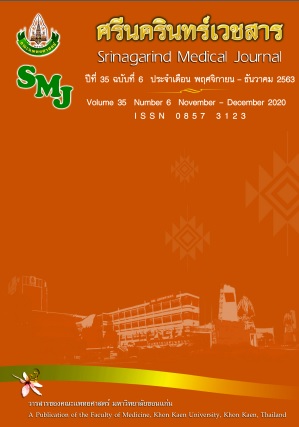Expression of Recombinant Peptide LcI from Bacillus amyloliquefaciens KKU14 and Test for Its Inhibition on Burkholderia pseudomallei
Abstract
การแสดงออกของเปปไทด์ LcI สายผสมจาก Bacillus amyloliquefaciens KKU14 และการทดสอบความสามารถในการยับยั้ง Burkholderia pseudomallei
วจีอร อ้วนชารี1,3, โชติมา โพธิทรัพย์1,3, รศนา เสริมสวรรค์1,3, อัชฌา บุญมี2,3*
1ภาควิชาชีวเคมี คณะแพทยศาสตร์ มหาวิทยาลัยขอนแก่น
2ภาควิชาจุลชีววิทยา คณะวิทยาศาสตร์ มหาวิทยาลัยขอนแก่น
3ศูนย์วิจัยโรคเมลิออยโดสิส มหาวิทยาลัยขอนแก่น
หลักการและวัตถุประสงค์: Burkholderia pseudomallei เป็นเชื้อก่อโรคเมลิออยด์ รักษาได้ด้วยยาปฏิชีวนะ อย่างไรก็ตามพบการดื้อยาในเชื้อ B. pseudomallei หลายสายพันธุ์ ก่อนหน้านี้พบว่า Bacillus amyloliquefaciens KKU14 สามารถยับยั้งการเจริญของเชื้อ B. pseudomallei ได้ ผู้วิจัยจึงได้โคลนยีนสร้างสารต้านจุลชีพ LcI จาก B. amyloliquefaciens KKU14 และทดสอบการออกฤทธิ์ต้านเชื้อ B. pseudomallei สายพันธุ์ P37
วิธีการศึกษา: ค้นหาข้อมูลเปปไทด์ต้านจุลชีพของแบคทีเรีย B. amyloliquefaciens จากฐานข้อมูล GenPept (NCBI) ออกแบบไพรเมอร์และเพิ่มจำนวนยีนจาก B. amyloliquefaciens KKU14 ด้วยวิธี PCR โคลนยีนเข้า เวกเตอร์พาหะชนิดต่าง ๆ แสดงออกโปรตีน และทดสอบการต้านเชื้อ B. pseudomallei P37 ด้วยวิธี agar well diffusion และ in-gel overlay
ผลการศึกษา: สามารถโคลนยีน lcI ได้สำเร็จแต่พบการแสดงออกของเปปไทด์สายผสมเฉพาะในเวคเตอร์ pQE31 เท่านั้น เปปไทด์ที่แสดงออกมีขนาดประมาณ 10 กิโลตาลตัน อย่างไรก็ดีเปปไทด์สายผสมนี้ไม่สามารถยับยั้ง B. pseudomallei สายพันธุ์ P37
สรุป: ในเบื้องต้นเปปไทด์ LcI สายผสมจาก B. amyloliquefaciens KKU14 ไม่สามารถยับยั้ง B. pseudomallei สายพันธุ์ P37 ได้ อาจเกิดจากการพับตัวที่ไม่เหมาะสมของเอนไซม์สายผสม หรือเปปไทด์ที่มีฤทธิ์ต้านเชื้อ B. pseudomallei อาจเป็นเปปไทด์ชนิดอื่น หรืออาจต้องใช้การทำงานร่วมกันของเปปไทด์หลายชนิด ซึ่งจำเป็นต้องมีการศึกษาต่อไป
คำสำคัญ: Antimicrobial peptide; Recombinant LcI peptide; Bacillus amyloliquefaciens; Burkholderia pseudomallei
Background and objective: Burkholderia pseudomallei is a pathogenic bacterium, causing melioidosis, a serious infectious disease. Currently, the best treatment is using antibiotic drugs. However, many clinical strains are now intrinsically resistant to almost all available antibiotic drugs. Previous study indicated that Bacillus amyloliquefaciens KKU14 strongly inhibits B. pseudomallei. In this study, antimicrobial peptide LcI of B. amyloliquefaciens KKU14 was cloned and expressed to test activity against B. pseudomallei.
Materials and Methods: Antimicrobial peptide LcI was searched from GenPept database (NCBI) and amplified from genome of B. amyloliquefaciens KKU14 by PCR and cloned into different cloning vectors. The recombinant clones were induced and their activity against B. pseudomallei strain P37 were tested by agar well diffusion and in-gel overlay.
Results: The recombinant peptide was successfully cloned. However, the expression could be observed only in pQE31 vector. The expressed peptide has the size of approximately 10 kDa. Nevertheless, the recombinant clones exposed no antimicrobial activities against B. pseudomallei strain P37.
Conclusion: The recombinant peptide LcI cloned from B. amyloliquefaciens KKU14 does not inhibit B. pseudomallei strain P37 in this study. This might due to improper folding of the recombinant peptide, or the peptide that was responsible for inhibition of B. pseudomallei might be other peptides, or the inhibition effect might need synergistically work from several peptides together, which has to be further investigated.
Key words: Antimicrobial peptide, Recombinant LcI peptide, Bacillus amyloliquefaciens, Burkholderia pseudomallei


